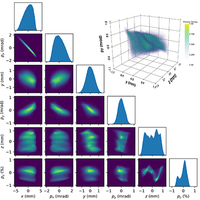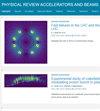利用生成式机器学习从实验测量中高效重建六维相空间
IF 1.8
3区 物理与天体物理
Q3 PHYSICS, NUCLEAR
Physical Review Accelerators and Beams
Pub Date : 2024-09-11
DOI:10.1103/physrevaccelbeams.27.094601
引用次数: 0
摘要
下一代加速器的概念取决于光束分布的精确塑造,因此需要同样精确的诊断方法,能够在六维位置-动量空间内重建光束分布。然而,使用当前的诊断技术来描述六维光束分布中的复杂特征,需要进行大量的测量,耗费许多小时的宝贵光束时间。我们需要新的相空间重建技术,以减少重建详细的高维光束特征所需的测量次数,从而解析复杂的光束现象,并作为精确光束整形应用的反馈。在本研究中,我们提出了一种新方法,利用生成式机器学习和可微分光束动力学模拟,从实验测量结果中重建详细的六维相空间分布。我们证明了这种方法可以用于从头开始解析六维相空间分布,只需使用基本的光束操作和少至 20 次的光束剖面二维测量。我们还演示了重构方法在阿贡韦克菲尔德加速器实验环境中的应用,它能够重构光束分布并准确预测以前未见过的测量结果,比以前的方法快 75 倍。本文章由计算机程序翻译,如有差异,请以英文原文为准。

Efficient six-dimensional phase space reconstructions from experimental measurements using generative machine learning
Next-generation accelerator concepts, which hinge on the precise shaping of beam distributions, demand equally precise diagnostic methods capable of reconstructing beam distributions within six-dimensional position-momentum spaces. However, the characterization of intricate features within six-dimensional beam distributions using current diagnostic techniques necessitates a substantial number of measurements, using many hours of valuable beam time. Novel phase space reconstruction techniques are needed to reduce the number of measurements required to reconstruct detailed, high-dimensional beam features in order to resolve complex beam phenomena and as a feedback in precision beam shaping applications. In this study, we present a novel approach to reconstructing detailed six-dimensional phase space distributions from experimental measurements using generative machine learning and differentiable beam dynamics simulations. We demonstrate that this approach can be used to resolve six-dimensional phase space distributions from scratch, using basic beam manipulations and as few as 20 two-dimensional measurements of the beam profile. We also demonstrate an application of the reconstruction method in an experimental setting at the Argonne Wakefield Accelerator, where it is able to reconstruct the beam distribution and accurately predict previously unseen measurements faster than previous methods.
求助全文
通过发布文献求助,成功后即可免费获取论文全文。
去求助
来源期刊

Physical Review Accelerators and Beams
Physics and Astronomy-Surfaces and Interfaces
CiteScore
3.90
自引率
23.50%
发文量
158
审稿时长
23 weeks
期刊介绍:
Physical Review Special Topics - Accelerators and Beams (PRST-AB) is a peer-reviewed, purely electronic journal, distributed without charge to readers and funded by sponsors from national and international laboratories and other partners. The articles are published by the American Physical Society under the terms of the Creative Commons Attribution 3.0 License.
It covers the full range of accelerator science and technology; subsystem and component technologies; beam dynamics; accelerator applications; and design, operation, and improvement of accelerators used in science and industry. This includes accelerators for high-energy and nuclear physics, synchrotron-radiation production, spallation neutron sources, medical therapy, and intense-beam applications.
 求助内容:
求助内容: 应助结果提醒方式:
应助结果提醒方式:


